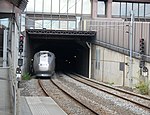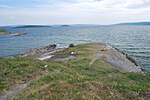Lindøya
Airports in OsloDefunct airports in NorwayIslands of OsloOslo geography stubs
Lindøya is a small island located in the Oslofjord, just south of central Oslo. Administratively it belongs to the borough of Gamle Oslo. In 1920, Lindøya was the Oslo base for the pioneer Norwegian airline, Det Norske Luftfartrederi, and its seaplanes. The operation only lasted until the autumn of 1920. When regular seaplane routes were again established in 1927, the operation was moved to neighboring Gressholmen.
Excerpt from the Wikipedia article Lindøya (License: CC BY-SA 3.0, Authors).Lindøya
German Bunker, Oslo Gamle Oslo
Geographical coordinates (GPS) Address Nearby Places Show on map
Geographical coordinates (GPS)
| Latitude | Longitude |
|---|---|
| N 59.8906 ° | E 10.7119 ° |
Address
Lindøya naturreservat
German Bunker
0252 Oslo, Gamle Oslo
Norway
Open on Google Maps











